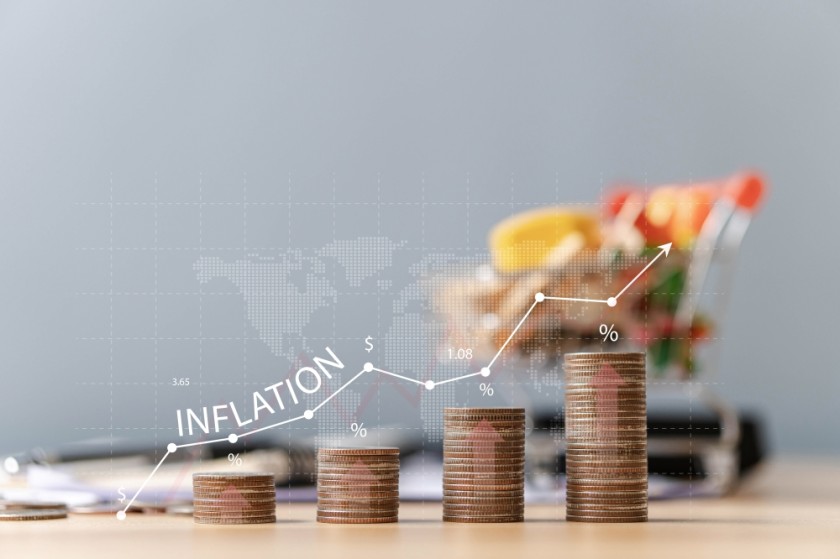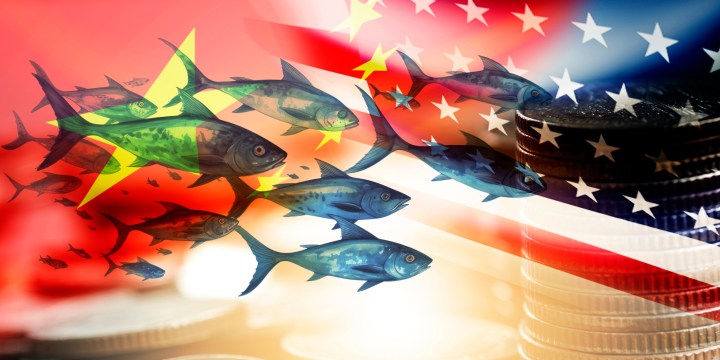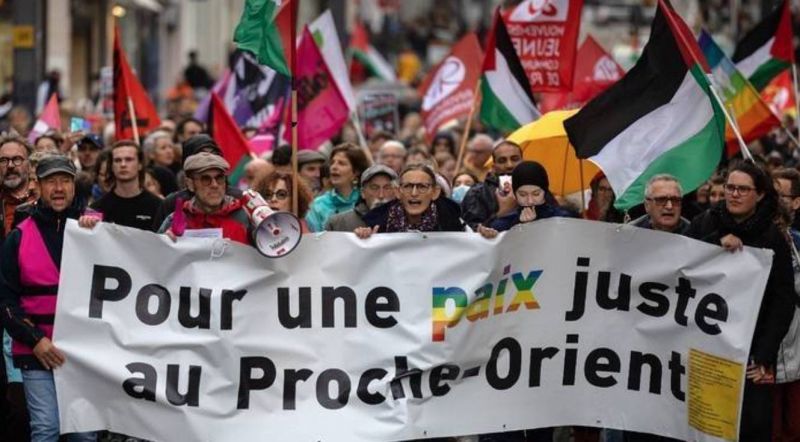The US is poised to take the lead and dictate the terms of energy trade in the coming decades. The sanctions on the Arctic LNG 2 are believed to be a precursor of this changing scenario.

Novatek’s LNG construction centre near Murmansk.
K.M. Seet
The new bouts of sanctions the United States recently imposed on Russia apparently signal a strategic shift in the world energy order. The latest sanctions on Russia’s Arctic liquefied national gas (LNG) 2 project – imposed as a penalty for its war on Ukraine – have different ramifications. Insofar as a new geopolitical dynamic takes shape in the already volatile Arctic region, Washington appears determined to prevent Russia from gaining prominence in the global energy market.
Does the emerging strategic landscape – with the continuing war in Ukraine and the new spell of war in the Middle East – augur well for the international correlation of power dynamic, with all its attendant implications for the global energy supply chains? Though it is too early to suggest a quick revival/reversal in the coming months, the global market is expected to grapple with disruptions and shortfalls in the energy sector, in one way or the other. Perceptibly, the United States is poised to take the lead and dictate the terms of energy trade in the coming decades. The sanctions on the Arctic LNG 2 are believed to be a precursor of this changing scenario.
Obviously, Russia’s invasion of Ukraine reshaped global energy supply chains, propelling the US to the forefront of the world’s energy-exporting nations. As Europe faced challenges in its natural gas imports from Russia, US exporters redirected shipments of LNG from Asia to Europe. With Russian oil under sanctions and the European Union rejecting Moscow’s seaborne cargoes, there has been a substantial increase in US crude and refined product exports to Europe.
This shift marked a significant transformation, with the US evolving from a supplier of “military arsenal” to a major energy arsenal, as noted by John Kilduff, a partner at Again Capital. Already, indications in this direction have come from US officials.
In a special briefing on October 13, 2023, Geoffrey R. Pyatt, assistant secretary of state for energy resources, said that the US was “committed to working in lockstep both to impose a price on Russia for its brutal invasion, but also to ensure that we deny Putin the resources that he is using in order to prosecute this terrible war against the people of Ukraine”. And in the case of its G7 partners in particular, the US is “also committed to working jointly to deny Russia future energy revenues and to target in particular investments and projects which are aimed at growing Russia’s future energy revenue”. Pyatt said: “That is the reason, for instance, why you saw our last sanctions package including measures specifically targeting the Arctic LNG 2 project in Russia. Our aim there, again, is to deny Russia future energy revenue.”
On October 24, Pyatt said: “Russia’s invasion of Ukraine overturned the international energy order.” With “Russia’s weaponisation of its oil and gas resources, … [it] is never going to be viewed again as a reliable energy supplier.” Pyatt pointed out “the remarkable success with which Europe has de-risked its dependency on Russian gas”. He said “American producers have played an indispensable role in helping to fulfil European energy security …”
Pyatt further said: “Russia which until 2022 was the world’s largest oil and gas exporter, has now put itself more or less permanently into the penalty box. And I think however and whenever the tragedy in Ukraine comes to an end, the market is never again going to look at Russia as a reliable investment location or look at Russia as a reliable supplier. So that means…there is going to be continued demand for energy that the United States produces.”
In his interaction with James O’Brien and Pyatt on November 8, US Senator Chris Murphy spoke at a US Senate Foreign Relations Committee hearing on U.S. national security interests in Ukraine. He said: “But the IEA projects Russia’s share of globally traded oil is going to fall by 50% by 2030, and their net income from gas sales is going to fall from $75 billion to $30 billion. You’re spending already 6% of your GDP, and you have a potentially catastrophic fall coming in oil and gas revenue. That is one of the things, maybe the primary factor that may push Russia to the table to try to drive a conclusion to this conflict.”
Pyatt, however, pointed out that there is a “structural decline in oil and gas revenue that Russia is confronting”. He said: “We are working as hard as we can to accelerate that trend. We do that through two mechanisms; One is by accelerating our energy transition, both here in the United States but also globally, as the Biden administration has done through the Inflation Reduction Act to reduce the dependence on fossil fuels. …But the other aspect of this is what we are doing systematically to reduce Russia’s future energy revenue. Just last week, for instance, we levelled new sanctions against a project in the Arctic, Arctic LNG 2, which is Novatech’s flagship LNG project, which Novatech set in motion with the aspiration of developing Russia as the largest LNG exporter in the world. Our objective is to kill that project. And we’re doing that through our sanctions working with our partners in the G7 and beyond.”
Arctic LNG 2 project
The Arctic LNG 2 project, managed by Russia’s Novatek, focuses on natural gas extraction and liquefied natural gas (LNG) production. On November 2, the US included the Arctic LNG 2 project into its sanctions list, targeting Russia’s energy sector production and export capabilities. The project is run by LLC Arctic LNG 2, a joint venture with PJSC NOVATEK (60%), TotalEnergies consortium (10%), Chinese corporations CNPC (10%) and CNOOC (10%), and JAPAN ARCTIC LNG (a consortium of Japanese companies MITSUI and JOGMEC) (10%). These sanctions are part of a broader punitive measures by the US against Russia, emerging from the full-scale invasion of Ukraine in 2022.
Novatek has been actively advancing the Arctic LNG-2 project, a significant initiative aimed at substantially increasing LNG production. The project is envisaged to elevate Russia’s global market share in LNG to 20%, and particularly it stands as a one-of-a-kind undertaking on a global scale.
Russian President Vladimir Putin launched the first completed production line for LNG on a gravity-based platform within the Arctic LNG-2 project, situated in Murmansk. This colossal platform, weighing over 600,000 tonnes, is set to be pushed along the Northern Sea Route to the Utrenneye field on the Gydan Peninsula in the Yamal-Nenets Autonomous Area.
Upon the full realisation of the project, Arctic LNG-2 will feature three liquefaction trains capable of producing a total of 19.8 million tonnes per annum (MTPA) of LNG, along with up to 1.6 MTPA of stable gas condensate (SGC). The scale and uniqueness of this endeavour underscore its significance in Russia’s strategy to enhance its presence in the global LNG market.
Russia has dismissed the impact of Western sanctions, asserting that they are employed by the United States to eliminate Moscow as a competitor in the global energy supplies arena. These sanctions do not directly apply to the project or its shareholders. However, concerns were raised about potential complications in how Mitsui and JOGMEC provide support for the project, possibly leading to delays in production, according to Russian sources.
The Arctic LNG-2 project is distinguished by several key features. It represents the world’s inaugural initiative for the serial production of liquefied natural gas (LNG) lines based on gravity-based structures (GBS). The utilisation of this construction technology, coupled with the substantial localization of equipment and material production in Russia, ensures cost-effectiveness, boosting the competitiveness of Russian LNG globally.
According to Russia, Arctic LNG-2 also adheres to high environmental standards, as the GBS construction eliminates the need for a liquefaction plant at the production site. Instead, LNG lines are linked from the Murmansk region to the Yamal field along the Northern Sea Route (NSR), thereby reducing environmental impact. Furthermore, the project enhances energy efficiency, resulting in a more than 30% reduction in greenhouse gas emissions per tonne of LNG compared to the industry average. This positions Russia favourably amid the global transition to a low-carbon economy.
The successful commissioning of Arctic LNG-2 is anticipated to significantly increase Russia’s overall LNG production, accounting for over half of the load of the NSR by 2030, as projected by the Russian government. Moreover, the project contributes to the development of the Russian Arctic economy, involving numerous domestic enterprises and creating over 80,000 jobs across the country. Arctic LNG-2 represents Russia’s third LNG project, following the Sakhalin-2 project launched in February 2009 and the Yamal LNG project initiated in December 2017. Upon completion, Arctic LNG-2 is expected to contribute approximately 19.8 million tonnes per year, equivalent to 27 billion cubic meters of gas annually, according to Konstantin Simonov, the director-general of the National Energy Security Fund. Russia is not only a major producer of LNG but also a significant supplier of pipeline gas, solidifying its position as one of the largest energy producers globally. Despite facing Western energy embargoes in response to the commencement of the war in Ukraine, Russia continues to supply more gas to world markets, both in pipeline and liquefied forms, according to Simonov.
The major consumers of LNG are primarily Asian countries, including China, Japan, South Korea and India. Spain and France are also significant European importers of Russian LNG, particularly from the Russian Arctic. The increased capacities of the Arctic LNG-2 project are expected to amplify the volume of LNG deliveries to these countries, utilising the Northern Sea Route (NSR) as a strategic transit route. This expansion aims to enhance Russia’s position in the global gas market, enabling it to manage the challenges of reconfiguring gas exports in the current geopolitical and economic conditions.
Western sanctions have presented new challenges for Novatek, the operator of the Arctic LNG 2 project, as outlined by Simonov. The primary segment of the first line of Arctic LNG 2 was produced before the imposition of sanctions on Russia’s LNG industry. Novatek had utilised technologies from the German company Linde, with other foreign suppliers, including the American company Baker Hughes, also contributing to the project. However, post-sanctions, Baker Hughes refused to supply the full number of turbines required for the project. Critics said that rather than hindering Russia’s industrial development, Western sanctions would serve as a catalyst for boosting domestic producers and technologies
The US is actively collaborating with partner countries to address sanctions on the Russian LNG project in the Arctic. The Office of Foreign Assets Control, a division of the Treasury Department, issued a general license that permits the wind-down of transactions related to Arctic LNG-2. This authorisation is effective through January 31, 2024. The spokesperson from the State Department emphasised ongoing coordination with partner nations as the January deadline approaches.
Novatek holds a 60% stake in the Arctic LNG-2 project and aims to commence production by the end of the year. This project is pivotal for Russia’s ambitions to secure 20% of the global LNG market by 2035, up from the current 8%. The new sanctions on the Arctic LNG-2 project are specifically targeted at degrading Russia’s future energy production and export capabilities, while ensuring the continued flow of energy to global markets, according to a spokesperson from the US State Department.
The spokesperson emphasised that the US does not have a strategic interest in reducing the global supply of energy, as this would lead to increased energy prices worldwide, benefiting Moscow. Despite the sanctions, the US maintained its position as the world’s largest LNG exporter in the first six months of the current year, as reported by the Energy Information Administration. The State Department spokesperson underscored the importance of close coordination with partners on sanctions issues and affirmed the continuation of such collaboration.
Changing energy landscape
The world is currently grappling with different dimensions of the energy crisis, characterised by unprecedented challenges. Russia’s invasion of Ukraine no doubt transformed the economic recovery from the pandemic into a full-fledged energy disorder. As the largest global exporter of fossil fuels, Russia’s restrictions on natural gas supply to Europe, coupled with European sanctions on Russian oil and coal imports, are disrupting a crucial route of global energy trade. While all fuels are impacted, gas markets are at the forefront, with Russia attempting to exert influence by subjecting countries to higher energy costs and supply deficits. Spot prices for natural gas skyrocketed to unprecedented levels. The soaring prices of gas and coal contributed significantly to a 90% increase in electricity costs worldwide. To compensate for the shortfall in Russian gas supply, Europe sought to import additional quantities of LNG.
Key players in Russia’s gas production include Gazprom and Novatek, while several oil companies, including Rosneft, also contribute to gas production. Gazprom, a state-owned entity, remains the largest gas producer, although its share has decreased over the past decade due to expansions by Novatek and Rosneft. Nevertheless, Gazprom still contributed to 68% of Russian gas production in 2021. Geographically, gas production has shifted from West Siberia to areas like Yamal, Eastern Siberia, the Far East and offshore Arctic regions.
Russia’s extensive gas export pipeline network includes transit routes through Belarus and Ukraine, as well as direct pipelines into Europe (such as Nord Stream, Blue Stream and TurkStream). The completion of the Nord Stream II pipeline in 2021 faced challenges as the German government withheld certification following the Russian invasion of Ukraine. Russian natural gas accounted for a significant portion of European Union gas demand, representing 45% of imports and nearly 40% of demand in 2021, with Germany, Turkey and Italy as the primary importers.
Russia’s strategic initiatives include the Power of Siberia pipeline, a major eastward gas export pipeline connecting far east fields directly to China. With a capacity of 38 bcm, it aims to gradually increase exports to 38 bcm in the coming years. Russia is also contemplating the development of the Power of Siberia-2 pipeline, which could supply China from West Siberian gas fields.
Diversification efforts extend to LNG development, with Russia targeting 110-190 bcm/year LNG exports by 2025. In 2021, Russia ranked as the world’s fourth-largest LNG exporter, shipping 40 bcm and constituting around 8% of global LNG supply. Also, Russia’s focus on the Arctic aims to boost oil and gas production, leveraging over 80% of natural gas production and an estimated 20% of crude production. While climate change poses challenges, it also opens opportunities for expanded access to Arctic trade routes, enhancing flexibility in seaborne fossil fuel deliveries, especially to Asia.
According to estimates from both the Organisation of the Petroleum Exporting Countries (OPEC) and the International Energy Agency (IEA), global energy demand is expected to increase by 40-60% by 2040 compared to 2010 levels. In this future energy landscape, oil is anticipated to maintain a leading role, constituting 25-27% of the total supply, while gas will make up 24–26% (compared to today’s figures of 35% and 26%, respectively). Notably, a significant portion of oil and gas production in 2040 is projected to occur in deposits that have yet to be explored.
Given these forecasts and considering the potential of undiscovered oil and gas reserves in the Arctic Shelf, estimated at 90 billion barrels of oil and 47 trillion cubic meters of natural gas, the offshore resources in the Arctic could play a crucial role in sustaining current production levels and fostering future growth in the medium and long term. This underscores the strategic importance of the Arctic region in meeting global energy demands and shaping the future of the oil and gas industry. However, with the new sanctions in place, and as Washington’s ambitious energy drive gets underway, it remains to be seen if Russia will be able to appropriate the oil and natural gas reserves in the Arctic.
K.M Seethi, an ICSSR Senior Fellow, is Academic Advisor to the International Centre for Polar Studies (ICPS) and Director, Inter University Centre for Social Science Research and Extension (IUCSSRE), Mahatma Gandhi University, Kerala.







:quality(70)/cloudfront-eu-central-1.images.arcpublishing.com/thenational/QVLVTQEQPGXCNYO2A7QBRG4KM4.jpg)
:quality(70)/cloudfront-eu-central-1.images.arcpublishing.com/thenational/BQDFZ3ORZ5QIUFAIQ5YW6K5UQI.jpg)
:quality(70)/s3.amazonaws.com/arc-authors/thenational/399d8b78-5b30-4bb8-892a-8a457e4a5ca2.png)
